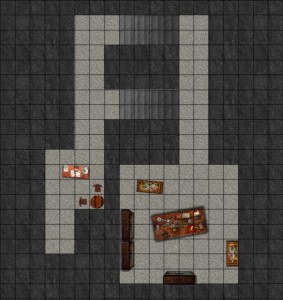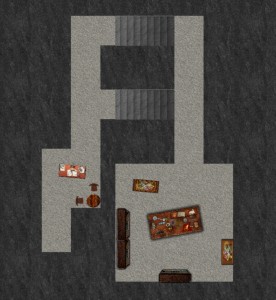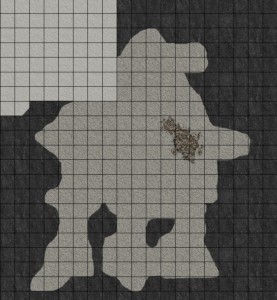I had the pleasure of having my gaming group over to the house on Sunday for our first playtest of D&D Next. We played for about 4 hours, with the first 30 minutes being about character selection and rules discussion and the last 30 minutes for talking about the session and providing feedback.
First, I want to give a big shout-out to the Weem, who provided a great map for the Caves of Chaos that I used in my MapTool + projector setup at the table. It’s so nice to not have to draw the maps myself! I’ll admit that I was a moron and that it took me a while to realize that each square represented 10 feet instead of 5, but that’s not Weem’s fault – the map says it quite clearly!
Preparation
Since I always run my games via MapTool, even in-person, I started by plopping the Weem’s map into a fresh campaign file, and then built some monsters. I began with my own 4e campaign framework, and then stripped things down to work for D&D Next. This was mostly easy, though it was a bit messy to write a macro that correctly handles advantage and disadvantage. I got there, though!
There are 34 monsters in the Bestiary for Next, and I prepped about 20 of them prior to the game. They’re pretty quick to put together, fortunately. I like that! Note that prepping them means that I’ve set up tokens in MapTool with an appropriate image, the right stats (hit points, AC, ability scores, speed, XP, etc.), buttons to track damage and buttons for each attack that the monster has.
The characters
Since we had six players and only five pre-generated characters, the party chose to double up on the dwarf fighter. Since it’s a hill dwarf, the first player to pick the character decided that it was a hillbilly dwarf. He named the character Bill to reflect this, which led the person playing the human cleric of Pelor to name his character Ted. The dwarf cleric of Moradin then became Rufus.
The party was rounded out with Gimli the dwarf fighter, Shazzam! the high elf wizzard (she likes the letter Z – and exclamation points), and Stealthy the halfling rogue (my wife likes Once Upon a Time, even though her character wasn’t a dwarf).
I’ll note here that one of my friends was interested in the rogue until he discovered that hiding takes an action. That was a bummer for him.
The adventure begins
My players tend to be more interested in killing bad guys and taking their stuff and less interested in plot. This worked fine with the Caves of Chaos, which does not come with a plot by default. I gave my players some choice among the potential plots listed in the adventure, and they liked the idea of seeking the piece of the Eye of Gruumsh that had ended up in the Caves of Chaos. Off we go!

The group decided to look for tracks near the first cave they saw (Cave A on the map), and a good Wisdom check from Ted revealed kobold tracks. When he went closer to the cave mouth to listen, some kobolds revealed themselves and combat began.
I decided to run this combat in the “theater of the mind”, so we rolled initiative and started killing kobolds. They only had two hit points each, which meant that both fighters and the wizard could reliably kill one kobold per turn (the fighters with the miss effect on their attack and the wizard with Magic Missile). The little lizard creatures went down pretty quickly. This entire combat took all of 10 minutes and 15 seconds. Not bad for fighting nine kobolds with six PCs!
The kobolds didn’t have any treasure or distinguishing markings, so the party left the bodies alone and moved into the cave. They saw a passage sloping down to the right, and to the left was a passage with a nasty smell. They decided to investigate the smell and found a garbage pit full of rats.
Rat stomping
Combat number two was another “theater of the mind” one, with the tiny rats swarming all over the PCs. I decided to throw 24 rats at them – four per PC. The rats started nibbling at PC ankles, and the characters started stomping on them.
When the wizard’s turn came around, she decided to use Burning Hands – our first Vancian spell! She waited until her friends got out of the way, then toasted a dozen rats.
Bill the dwarf fighter strode boldly into the garbage pit and took out the dire rat in one shot, and when the three surviving rats had a turn in round three, they fled. This combat took only 13 minutes; not too shabby.
Traps!
From here, the party started heading down the slope, only to trigger a pit trap. Three PCs fell in, and attracted the attention of four kobolds. Our rogue spent the first round of combat fiddling with the trap to get it open so that the fallen PCs could climb out.
We noticed here that the jumping and climbing rules make pit traps not very scary once they’ve triggered. Getting out of the trap is easy enough; unless the walls are particularly slick, you can climb right out at half speed. As for the people who didn’t fall in, they could jump a number of feet (edit: I originally said “squares” instead of “feet here – not what I meant!) equal to their Strength score, which was at least 8. Add in two feet for extending your arms, and even the wimpy wizard could jump, grab the far edge, and pull herself up. Maybe I was too easy on my PCs here, but that’s the way I ran things.
Anyway, the fight against these four kobolds was pretty easy for the party since they had bright light, giving the monsters disadvantage on their attacks. As I wrote about recently, disadvantage is a big deal, equating to about a -4 or -5 to attack. Still, with all of the shenanigans surrounding the pit trap, this combat took 19 minutes. It’s amazing that this feels like a long combat!
The little boss – a battle with a map
From here, the gang noticed that the passageway eventually ended at a large chamber filled with dozens of kobolds. I decided that this chamber would probably actually have a door, so I created one on the fly. They decided to explore a different passage instead, finding themselves at a locked door.
No problem – we have a rogue in the party! The pregen rogue has a very cool ability that says she can’t roll below a 10 for any skill that she’s trained in. So she rolls, and if it’s less than 10 we treat it as a 10 on the die. This means that opening locks is no worse than a 16 for her, which popped the storage room right open.
The most interesting item in this room was a cask of wine, which one of our fighters created a hole in with his axe. He then replaced the water in his waterskin with wine.
From here, the next clear direction was down the hall to a chamber that had three tougher-looking kobolds standing around and talking. A frontal assault was declared, and we rolled initiative. I decided that, since there were two waves to this fight and the enemies had the potential to actually take a hit and keep fighting, we would use the map and minis.
All three of the “elite” kobolds were dead by the end of the first round. In the second round, six more regular kobolds came out of a far room, escorting their chieftain. The chief actually had some hit points, but it didn’t matter – he never landed a blow with his axe, even though he was getting two attacks per round. He always had disadvantage thanks to the bright light from the wizard. The whole battle took just under 20 minutes.
Getting a little bit of treasure in the chief’s room was a nice find for the party, although the wizard continued to be disappointed with the lack of hits from her Detect Magic. No magic loot here, guys – this isn’t 4th Edition any more!
Kobold genocide?
The only remaining chamber in this part of the Caves of Chaos was the one that had dozens of kobolds in it. Back down the hall the party went, checking for traps and then opening the door.
They saw a group of 36 adult kobolds in their living quarters, with eight kobold hatchlings in the back corner of the room. A debate ensued among the party members about what to do – kill them or leave? Bill the fighter won initiative and decided to step into the room, slaughter a kobold, and then step back.
At this point, the kobolds reached for their daggers and started throwing, mostly at Bill but some at Gimli who was next to him. Rufus, the cleric of Moradin, was standing right behind them, which meant that her Guardian ability kicked in – all of the kobolds would have disadvantage on their attacks.
Thankfully, I was using the computer to roll the dice. Having to roll twice for each of 35 kobolds would have been a major pain in the butt. When all was said and done after those 35 attacks, the kobolds had only dealt 5 damage – 5 dagger hits for 1 damage each. Disadvantage is POWERFUL! They only needed to hit AC 15, but you only have a 12% chance of doing that when you’re just +1 on your dagger attack and you have disadvantage.
The rogue, the wizard and the cleric of Pelor shot some bullets and magic at kobolds as they backed down the hallway. The cleric of Moradin stayed in place to provide her fighter allies with some protection, but she refused to slaughter the kobolds.
In round two, we had 33 kobolds attacking the fighters with disadvantage. A few more points of damage landed, but nothing too serious. At this point, the cleric of Pelor left her fighters alone with the kobold menace.
Now the kobolds could show what they could do. Since they were out of the bright light, the Guardian was gone and they outnumbered the fighters, this meant the kobolds now had advantage on their attacks. Spears and daggers started landing left and right, and before half of the surviving kobolds had acted, they had dropped both fighters to unconsciousness. The kobolds slammed the doors to their chamber.
The surviving party members came back, stabilized their fighters, and dragged them out of there. The aborted kobold massacre took about 18 minutes, including some time at the end that was just about the dragging of the fighters out of the kobold caves.
Opinions
I’ll put up another post later with our actual feedback from the playtest, but I’d say it was a successful test overall. There’s no way we would be switching from 4e to this game in its current state, but everyone seemed to feel like it has real potential. The one person in our group who’s been playing for 30 years especially enjoyed the game.
We’ll keep on testing, of course. There are plenty of things that we weren’t crazy about, but we feel like this game can be a good one. Definitely a promising start!
-Michael the OnlineDM
OnlineDM1 on Twitter





